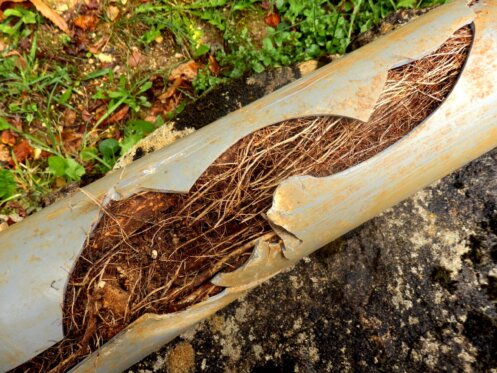How Tree Roots Can Damage Your Sewer Lines
Even when your yard looks healthy on the surface, tree roots can quietly push deeper in search of moisture, often making your sewer line their next stop. Even a small crack or loose joint is enough to attract roots that squeeze in and take over. At Crystal Blue Plumbing Heating & Air, in Sacramento, CA, we’ve helped homeowners spot these underground problems before they turn into massive messes.
Roots Don’t Wait for an Invitation To Your Yard
As trees grow, their roots push through the soil looking for nutrients and moisture. If your sewer line is nearby, that’s where they’re headed. Even small cracks or worn-out seals are enough for roots to sneak in. You might think the pipe is solid, but tree roots don’t need much space. Once inside, they thicken fast. They don’t just sit there. They expand, twist, and press against the pipe walls.
Pipe Materials Matter
Not all sewer lines have the same level of defense. Older homes may still rely on clay or cast iron pipes, which crack more easily than modern materials. Clay tends to shift when soil moves, especially during wet or dry seasons. That shifting leads to small gaps between pipe sections, which roots find quickly.
Cast iron is stronger but corrodes with age, and corrosion leads to rough patches where roots can grab hold. PVC pipes do better at keeping roots out, but they’re not perfect. If the pipe wasn’t installed well or if the soil has moved, even PVC joints can separate. Once a root finds a way in, it doesn’t stop. The damage might begin with a crack or a loose seam, but it spreads fast. A few strands become a thick mass that blocks the entire flow.
Slow Drains May Mean Trouble
When your sinks or toilets drain more slowly than usual, it’s easy to blame it on something simple like hair or grease. But if the problem keeps coming back, even after snaking or plunging, there’s a good chance roots are part of the picture. Tree roots don’t just create a clog. They trap other debris.
Every time you flush or rinse something down, it can catch on the root structure. That adds weight and stress to the pipe and makes the flow worse. You might notice gurgling in the toilet, especially after using another drain. You might hear bubbling sounds in your sink or see water backing up in the tub. These signals don’t always mean a pipe has collapsed, but they almost always mean there’s more going on than surface-level blockage. Waiting too long could let a small root intrusion turn into a full pipe break.
Soil Movement Makes Root Invasion Worse
Soil doesn’t stay in one place, especially in areas with seasonal changes. Dry weather shrinks the ground, while rainy weeks can make it swell. Tree roots respond to those changes by growing in new directions. If the soil near your home dries out, roots move closer to sewer lines to follow the moisture. If the soil shifts too much, it can crack or offset a pipe that used to be stable.
Once there’s space, roots move in fast. You might not notice the pipe has shifted, but you might start to see other signs like wet patches in the yard, greener grass in one area, or a new dip forming in the lawn. Roots don’t cause all those issues alone, but once they get inside, they take advantage of any weak point the soil exposes.
Roots Can Block the Pipe Entirely
One of the biggest problems with tree root intrusion is that it builds quietly. You won’t always notice a sharp change in water flow. Sometimes the roots grow slowly and let the pipe keep working, for a while. But eventually, they block the flow completely. Water and waste have nowhere to go, and pressure builds behind the clog. That’s when you get a full backup. Water might spill from the floor drain in the basement. Toilets might overflow.
You might smell sewage before you see any water. These aren’t minor signs. At that point, the pipe may be beyond repair. Removing the roots isn’t enough if the pipe has broken or collapsed around them. A full replacement might be the only option, and that’s a more involved project than most homeowners expect. Keeping roots out early is much easier than fixing the damage they leave behind.
Video Inspections Give You a Clear Picture
If you suspect roots are in the line, guessing won’t help. You need to see what’s going on inside the pipe. That’s where a sewer camera inspection helps. A small, flexible camera feeds through the line and sends back a live view of the pipe. You can spot root intrusion, cracks, breaks, or buildup without digging. This is one of the most reliable ways to know what you’re dealing with. If roots are present, you’ll see exactly how far they’ve spread and where the entry point is.
That makes it easier to choose the right repair method. You might get by with hydro jetting if the pipe is still intact. If the pipe has cracked or shifted, a trenchless lining repair could work. If damage is widespread, a full replacement might be the safest call.
Prevention Begins With Tree Placement
Where you plant your trees makes a big difference. If one sits too close to the sewer line, it could cause a mess down the road. Some roots stay calm, but others spread fast and cause damage. If you’ve already got trees nearby, trimming the roots or adding a barrier might save you some stress.
A physical barrier, like a metal or plastic shield, can push roots downward or away from the line. These don’t stop growth completely, but they can make it harder for roots to reach the pipe. If you’re planting new trees, it helps to check where your sewer lines run before choosing a spot.
Hydro Jetting Can Remove the Problem Quickly
If roots have found their way inside but haven’t collapsed the pipe yet, hydro jetting is one of the fastest ways to clear them. This method uses a high-pressure stream of water to push apart and flush out the roots. It doesn’t damage the pipe if the material is still solid, and it clears the entire path at once.
Hydro jetting also removes any grease, buildup, or debris that may have gotten stuck on the roots. After a jetting session, most lines flow freely again. However, this only solves the blockage, not the entry point. If there’s a crack or a loose joint, roots will come back unless that weak spot is fixed.
Schedule a Sewer Pipe Inspection Today
Tree roots don’t wait for an invitation. They push through cracked pipes, clog your sewer line, and leave you dealing with backups and repairs that could have been avoided. If you’ve noticed yard puddles, odd smells, or sluggish drains, there’s a good chance something underground needs attention. Along with sewer line inspections and repairs, the team also handles drain cleaning and trenchless pipe solutions that help prevent future root damage without tearing up your yard.
Schedule a service today with Crystal Blue Plumbing Heating & Air.








